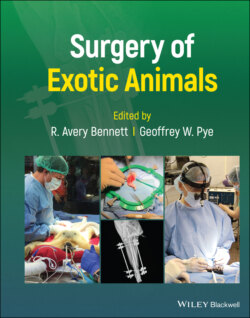Читать книгу Surgery of Exotic Animals - Группа авторов - Страница 107
Skin Surgery
ОглавлениеThe indication for surgery should be confirmed before performing a procedure. Surgical excision of masses associated with lymphocystivirus or cyprinid herpesvirus 1 (CyHV1) infections is not recommended, as they will spontaneously regress (Weber 2013). Surgical preparation should not disrupt the natural mucus layer of the integument. Mucus is critical for innate immunity and protection (Benhamed et al. 2014; Guardiola et al. 2014). Scale removal is recommended to facilitate skin closure and healing (Wildgoose 2000). Gently extract the scales with a pair of forceps along the incision line. Since fish scales are dermal in origin (Lee et al. 2013), this can damage the epidermis and should be accomplished with care to limit the resulting trauma to the skin and to leave the scale bed intact so that scales will regrow normally (Weber et al. 2009). Then gently flush with sterile saline or sterile water rather than typical surgical preparations (Lloyd and Lloyd 2011), as many surgical antiseptics have been reported to predispose fish to dermatitis and incisional dehiscence (Mylniczenko et al. 2007). Irrigate exposed skin and eyes with chlorine‐free water throughout surgery to avoid desiccation and secondary necrosis.
For skin biopsies, use a biopsy punch or scalpel blade. Achieve hemostasis using digital pressure or hand‐held electrocautery. Biopsy sites can be left open to heal by second intention. Compared to mammals, fish skin has very low elasticity due to the dermal scales (Wildgoose 2000). External mass incisional or excisional biopsy in fish is accomplished in a manner similar to that in mammals. Surgical margins are rarely obtained for neoplasia that involves the coelomic cavity (Figure 5.7) and body wall reconstruction should be planned carefully prior to mass resection due to the low elasticity of the tissues (Boerner et al. 2000; Wildgoose 2000). Intralesional chemotherapy based on a histologic diagnosis has been reported (Figure 5.8) (Vergneau‐Grosset et al. 2016; Stevens et al. 2017).
Figure 5.7 Excision of a neoplastic mass of the vent of a koi (Cyprinus carpio): the integrity of natural orifices and anatomy should be preserved as much as possible during mass excision.
Source: Photo courtesy: Companion Avian and Exotic Pet Medicine Service, University of California, Davis.
Operculoplasty is performed for esthetic purposes in fish with a laterally curled operculum, a common congenital problem in arowanas (Osteoglossum and Scelopages spp.) (Figure 5.9a). The etiology has not been determined and a genetic predisposition cannot be ruled out. Section the operculum with scissors at the level where it is still parallel to the long axis of the body (Figure 5.9b) and it will grow back straight. Some hobbyists also recommend filing the exposed opercular to the appropriate angle, but care should be taken not to damage the surrounding epithelium.
Oral surgery and incisive plate adjustments may be needed to improve food prehension due to insufficient wearing of the dental plates (Figure 5.10) or due to the presence of an oral mass. Incise the fibrous tissue with a scalpel blade in a medial to lateral direction and allow healing by second intention. Pufferfish have continuously growing incisor plates (Lécu and Lecour 2004). When fed exclusively soft food items such as pelleted diets, flakes, or soft prey instead of a natural diet that includes mollusks or crustaceans, they can develop overgrowth of their incisor plates (Figure 5.11a). Trim these plates with a dental burr or rotary tool (Dremel, Racine, WI) (Lécu and Lecour 2004) (Figure 5.11b). Take care to not overheat the incisor plates by prolonged contact with the burr. It may be necessary to fully immerse the pufferfish frequently to avoid inflation of the esophagus with air rather than water; water distention of the esophagus in these species is a normal physiologic defense, and fluid can be more easily expelled post procedure than entrapped gas (Wildgoose 2000).
Figure 5.8 Intralesional bleomycin injection into a myxoma on the head of an oranda goldfish (Carassius auratus). This treatment led to a decrease of the size of the mass for the following three months and was subsequently repeated as needed.
Source: Photo courtesy: Companion Avian and Exotic Pet Medicine Service, University of California, Davis.
